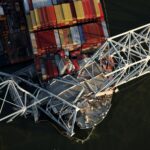Aon has released its “2008 Marine Insurance Market Review,” which concludes that the “marine industry is set for a continued run of favorable insurance premiums in 2008, despite facing higher risks. The cargo and liability markets offer a win-win situation to ship and cargo owners who are paying less and underwriters who remain profitable due to few claims — at least for the time being.”
Aon said that “rates for well-managed risks are expected to continue falling throughout 2008 by up to 10 percent. This positive outlook is due to a plentiful supply of capacity combined with a low level of claims creating fierce competition between underwriters. The relatively benign claims environment reflects major advances in recent years in ship design, cargo handling and general maritime safety.”
Aon found, however, that the situation is somewhat different for protection & indemnity (P&I) clubs, who have generally “announced big rate increases for 2008 in response to a surge in the size of large claims. Neither is the situation quite so rosy in hull and machinery, where losses are starting to impact the accounts of many insurers, although not to the same extent as in P&I.”
Aon singled out two continuing key risks that threaten to increase the shipping industry’s size and cost of claims, as follows:
— Crew shortages and a dwindling pool of skilled officers in the marine industry could result in increasing claims due to human error. At the same time, shipyards are working at full capacity on new builds and these additional ships will exacerbate the existing crew shortage, especially for complex vessels such as the new generation of LNG tankers. The industry must focus on recruitment, training and retention programs.
— Bigger ships, tankers and dredgers are creating bigger concentrations of risk and magnifying the potential scale of disaster for P&I, liability and cargo insurers as well as hull underwriters.
Peter Dobbs, CEO of Aon’s marine team, commented: “Although the short term prospects for insurers and shipowners are generally very favorable, the combination of falling premiums and rising risk does ultimately hold the potential to destroy this equilibrium. And, as we are seeing in the P&I market, that could provoke a dramatic response from insurers as they try to restore the balance between premiums and claims.”
The market in the United States closely resembles the international market, with a key exception. “U.S. marine insurers are generally responding to rate pressures in a parallel manner to international markets,” explained Bob DeMotta, managing director and head of the U.S. marine practice. “It is also historically true that in an upward market U.S. insurers will reach a price ceiling prior to their international counterparts.”
Despite new markets and capacity from Bermuda and elsewhere to write U.S. marine risks, Aon expects price reductions will begin to level off in the United States within the next 12 months.
DeMotta added that “this is also a great time to review policy wording and expand coverage where possible. For example, U.S. insurers are still the most familiar and comfortable with primary and low level excess liability layers involving U.S. exposures. We have a creative underwriting community that will consider coverage enhancements as a means to mitigating premium reductions.”
The report can be obtained on the Aon Risk Services section of Aon’s global online newsroom at: http://aon.mediaroom.com/index.php?s=55.
The report’s highlights include the following:
Hull — Rates are reducing by 5-10 percent. Insurer accounts are unlikely to be profitable due to the combination of falling rates and emerging losses — most are subsidizing hull business with profits from other lines. Korean, Japanese and Singaporean insurers are aggressively writing international tonnage.
Cargo — Ample capacity and few claims are resulting in savings of around 10 percent at renewal and profitable accounts for insurers. London maintains the role of leading rate setter on the majority of complex global placements. Meanwhile, Singapore is emerging as an international force for straightforward risks. Outside of London, insurers are willing to tempt clients with offers of much lower deductibles.
P&I — The surge in costly P&I pool claims in 2006 could be a sign of the times as booming shipping operations become more expensive. In anticipation, P&I clubs are already initiating increases of 10-20 percent in shipowners’ premiums at the next renewal in February 2008.
Liability — Rate reductions are expected around 5-10% percent. Liability deductibles are fairly stable after years of increases to stay ahead of rapidly rising litigation costs. Capacity is growing and becoming more global, notably in the Asian hubs of Singapore and Hong Kong.
Yachts — In 2004 the world population of super yachts (30 meters plus) was around 4,000. It now stands close to 7,000 and boat builders are struggling to keep pace with demand. After several years when annual increases were in the region of 10-15 percent, rates began to level off in 2006/7. By the end of 2007 early signs of softening had begun to emerge, but were generally limited to newly built vessels. Rates may come under slight pressure during 2008 simply because of the amount of capacity entering the market.
Source: Aon – www.aon.com
Was this article valuable?
Here are more articles you may enjoy.

 Viewpoint: How Generative AI Enables a Brighter Claims Future in 2024 and Beyond
Viewpoint: How Generative AI Enables a Brighter Claims Future in 2024 and Beyond  Report: Vehicle Complexity, Labor ‘Reshaping’ Auto Insurance and Collision Repair
Report: Vehicle Complexity, Labor ‘Reshaping’ Auto Insurance and Collision Repair  US Eyeing Ship’s Electrical System After Baltimore Bridge Crash
US Eyeing Ship’s Electrical System After Baltimore Bridge Crash  CoreLogic Report Probes Evolving Severe Convective Storm Risk Landscape
CoreLogic Report Probes Evolving Severe Convective Storm Risk Landscape 